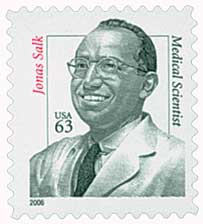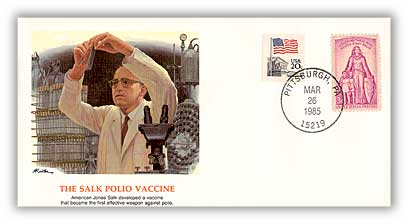
# 3187a FDC - 1999 33c Celebrate the Century - 1950s: Polio Vaccine Developed
33¢ Polio Vaccine Developed
Celebrate the Century – 1950s
City: Springfield, MA
Printing Method: Lithographed, engraved
Perforations: 11.5
Color: Multicolored
Birth Of Dr. Jonas Salk
Salk attended the Townsend Harris High School for gifted students and had a reputation for being a perfectionist. He would also read anything he could get his hands on.
From there, Salk went on to attend the City College of New York where he earned a degree in chemistry in 1934. He had originally wanted to study law and claimed he never had an interest in science as a child, but his mother urged him to pursue medicine. Salk then went to New York City Medical School. However, he didn’t want to study medicine, rather he preferred medical research.
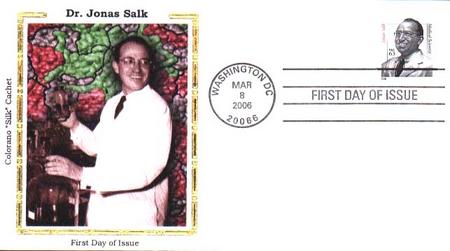
Salk soon focused his studies on bacteriology. He stated that he wanted to help humankind as a whole, instead of single patients. Salk was particularly influenced by his time in the laboratory of Thomas Francis, who studied the influenza virus. He helped develop the first effective influenza vaccine, still the basis of the flu vaccinations given today.
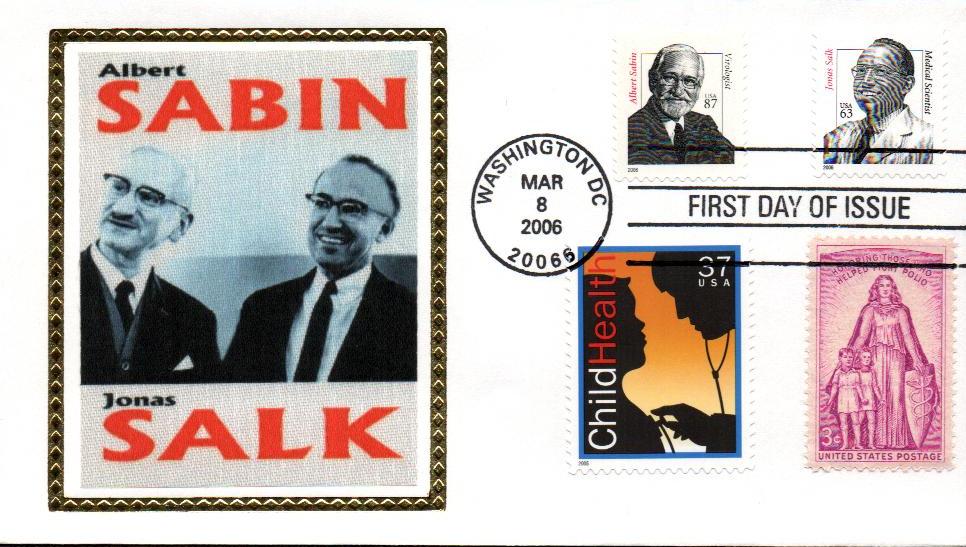
After graduating and completing his residency at Mount Sinai Hospital, Salk wanted to run his own lab. In 1947, he received one from the University of Pittsburgh School of Medicine. The following year, he was contacted by the National Foundation for Infantile Paralysis. They wanted him to try to find out if there were more than three types of polio known at the time. Paralytic poliomyelitis, or polio, was the most frightening public health problem facing America after World War II. Each year, thousands of people, mostly children, died or were permanently paralyzed by the disease.
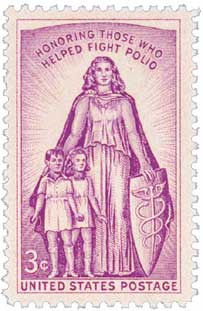
Salk assembled a research team and set up a lab. After extensive study, he decided to turn his attention toward creating a vaccine. At the time, most vaccines used live viruses, which was dangerous. Salk opted for using the safer “killed” virus. He conducted his first field tests in 1952; first on children who had recovered from polio, and later on those who had never had the disease. Both tests were successful, and his findings were published the next year in the Journal of the American Medical Association.
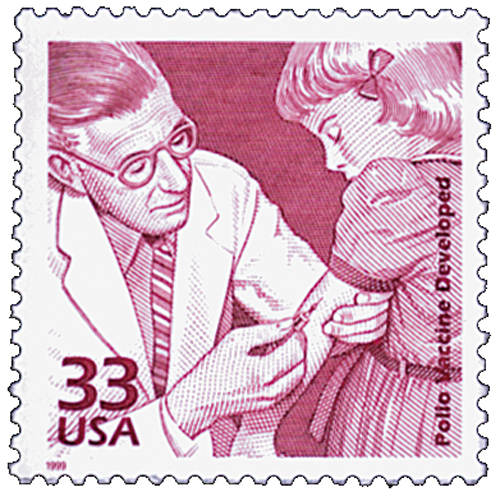
In 1954, tests were done on an even larger scale. The vaccine, injected with a needle, was found to reduce the incidence of polio. On April 12, 1955, it was declared safe and released for use in the US. It was the first effective polio vaccine and was added to the World Health Organization’s List of Essential Medicines. One of Salk’s contemporaries, Dr. Albert Sabin, developed an oral vaccine in 1957 that further helped to eradicate polio in the United States and most countries around the world.
Salk became an international celebrity, but he didn’t like the attention. He also received a presidential citation, the Presidential Medal of Freedom, several foreign and American awards, and four honorary degrees. But Salk wanted to continue his research. He established the Salk Institute for Biological Studies in 1963. He also spent the final chapter of his life researching a vaccine for AIDS. Salk died on June 23, 1995, in La Jolla, California.
33¢ Polio Vaccine Developed
Celebrate the Century – 1950s
City: Springfield, MA
Printing Method: Lithographed, engraved
Perforations: 11.5
Color: Multicolored
Birth Of Dr. Jonas Salk
Salk attended the Townsend Harris High School for gifted students and had a reputation for being a perfectionist. He would also read anything he could get his hands on.
From there, Salk went on to attend the City College of New York where he earned a degree in chemistry in 1934. He had originally wanted to study law and claimed he never had an interest in science as a child, but his mother urged him to pursue medicine. Salk then went to New York City Medical School. However, he didn’t want to study medicine, rather he preferred medical research.

Salk soon focused his studies on bacteriology. He stated that he wanted to help humankind as a whole, instead of single patients. Salk was particularly influenced by his time in the laboratory of Thomas Francis, who studied the influenza virus. He helped develop the first effective influenza vaccine, still the basis of the flu vaccinations given today.

After graduating and completing his residency at Mount Sinai Hospital, Salk wanted to run his own lab. In 1947, he received one from the University of Pittsburgh School of Medicine. The following year, he was contacted by the National Foundation for Infantile Paralysis. They wanted him to try to find out if there were more than three types of polio known at the time. Paralytic poliomyelitis, or polio, was the most frightening public health problem facing America after World War II. Each year, thousands of people, mostly children, died or were permanently paralyzed by the disease.

Salk assembled a research team and set up a lab. After extensive study, he decided to turn his attention toward creating a vaccine. At the time, most vaccines used live viruses, which was dangerous. Salk opted for using the safer “killed” virus. He conducted his first field tests in 1952; first on children who had recovered from polio, and later on those who had never had the disease. Both tests were successful, and his findings were published the next year in the Journal of the American Medical Association.

In 1954, tests were done on an even larger scale. The vaccine, injected with a needle, was found to reduce the incidence of polio. On April 12, 1955, it was declared safe and released for use in the US. It was the first effective polio vaccine and was added to the World Health Organization’s List of Essential Medicines. One of Salk’s contemporaries, Dr. Albert Sabin, developed an oral vaccine in 1957 that further helped to eradicate polio in the United States and most countries around the world.
Salk became an international celebrity, but he didn’t like the attention. He also received a presidential citation, the Presidential Medal of Freedom, several foreign and American awards, and four honorary degrees. But Salk wanted to continue his research. He established the Salk Institute for Biological Studies in 1963. He also spent the final chapter of his life researching a vaccine for AIDS. Salk died on June 23, 1995, in La Jolla, California.





